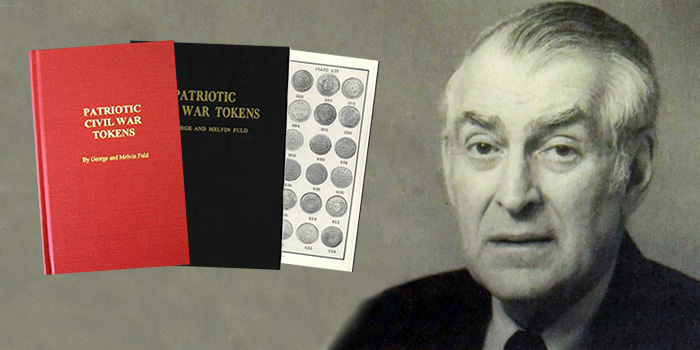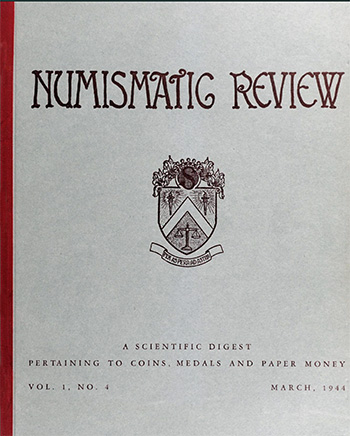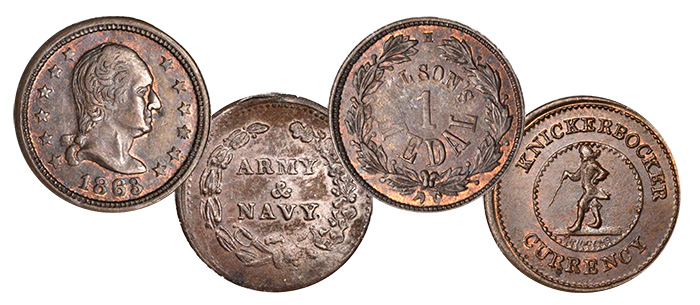
By Q. David Bowers – Stack’s Bowers ……
Over a long period of years, ever since I discovered the world’s greatest hobby in 1952 at the age of 13, I have studied and read avidly. Now, many years later I am still learning.
Along the way I have explored and have written books on colonial coins, various denominations of federal gold, Hard Times tokens, shell cards, silver dollars, commemoratives, and a lot more. Take a peek at the Whitman Publishing website and you can see which of my books are currently in print and available. This prompts me to say that if you plan to attend the Whitman Coin & Collectibles Expo in Baltimore, track me down. At the Whitman booth are many different books for sale.
A prime focus of the show will be the annual meeting of the Colonial Coin Collectors Club, a great organization. I will be giving a talk on colonials at their meeting.
As I write these words I have been spending some time at the bank, looking at tokens and medals, some of which I haven’t see for years. At age 77 I am deaccessioning many things, including consigning to Stack’s Bowers Galleries. It is time for others to own some of the things I have treasured.
Among the items I am arranging are Civil War tokens. I first learned of these in the 1950s and became fascinated immediately. Ever since then I have studied them intently and also collected many. It was in 1958 that I visited Dr. George J. Fuld at his home in Wakefield, Massachusetts. By that time he was already known as the expert on Civil War tokens, teaming with his father Melvin (who lived in Baltimore). George was a professor at the Massachusetts Institute of Technology (MIT) at the time.
Fast forward to about six or seven years ago when I began preparing a manuscript for A Guide Book of Civil War Tokens. This was published by Whitman in 2012 and became an immediate best seller. Today the second edition is in print and is widely used.
In connection with that book I invited George Fuld to write his reminiscences, which he did–preserving for all time the flavor of his enthusiasm. George has passed, but his Fuld catalog system will live forever, and those who knew him have fond memories.
I now turn this week’s blog over to George. Enjoy!
–Dave Bowers
Reminiscences by Dr. George Fuld
As of 1943, like many youngsters I started to collect Lincoln cents. By 1946 I was deeply involved in collecting all United States coinage, and had completed my Lincoln cent set as well as a set of Indian Head cents and was pursuing earlier years of this denomination. In 1947 I talked my father, Melvin Fuld, into taking me to the American Numismatic Association convention held that year in Buffalo. For a precocious kid of 15, this was such an eye-opening experience. I met two collectors who made a complete change in my collecting interest. They were William Guild of West Newton, Massachusetts (later Florida) and Bill Jacka of Bedford, Ohio. They both told me of a new collecting interest: Civil War tokens. They suggested that this was a wide open field with hundreds of different tokens available at 10 to 25 cents each.
At the show I met David Bullowa, who sold me dozens of different Civil War tokens at 25 cents each. At that time, my father had no interest in coin collecting. Over the next year or so he joined me in enjoying these tokens. In 1949, Bullowa acquired the 4,000+ collection of Civil War tokens formed by Joseph Barnet and advertised in The Numismatist. He wanted $2,500 for the collection, a “huge” sum for me at the time. I proposed that Bullowa buy my United States collection of cents complete from 1794 to date (except the 1856 Flying Eagle) as partial payment in the amount of $900. My father agreed to make up the difference in cash. We packed up our collection and drove from Baltimore to Philadelphia to make the trade.
 At that time the only reference available was the Hetrich and Guttag book published in 1924, Barnet had published an updated commentary on H&G varieties in The Numismatist and The Numismatic Review in 1943 and 1944. I aggressively continued to buy Civil War tokens, including small collections, and offered duplicates for sale. In 1951 my father and I bought the D.C. Wismer Collection of Civil War tokens, consisting of 11,000 pieces, from the New Netherlands Coin Company, at six cents each. We sold over 5,000 of these, packed in a wooden crate, to Tatham Stamp & Coin Co. in Springfield, Massachusetts. These were all duplicates, mainly the “Dix” patriotic tokens. The other major collection we acquired was Henry Guttag’s collection of about 5,000 pieces in 1958. It had first passed to Max Schwartz of New York City, who retained a hundred or so pieces, then to John Zug of Bowie, Maryland, who advertised it, but no buyer came forth. From there it went to New Netherlands, then to us. We traded with the few serious Civil War token collectors such as William Fayerweather, Clif Temple, Jim Curto, Ray Haggenjos, Charles Foster, Lionel Rudduck, Wayne Rich, Martin Jacobowitz, and Otto Kersteiner.
At that time the only reference available was the Hetrich and Guttag book published in 1924, Barnet had published an updated commentary on H&G varieties in The Numismatist and The Numismatic Review in 1943 and 1944. I aggressively continued to buy Civil War tokens, including small collections, and offered duplicates for sale. In 1951 my father and I bought the D.C. Wismer Collection of Civil War tokens, consisting of 11,000 pieces, from the New Netherlands Coin Company, at six cents each. We sold over 5,000 of these, packed in a wooden crate, to Tatham Stamp & Coin Co. in Springfield, Massachusetts. These were all duplicates, mainly the “Dix” patriotic tokens. The other major collection we acquired was Henry Guttag’s collection of about 5,000 pieces in 1958. It had first passed to Max Schwartz of New York City, who retained a hundred or so pieces, then to John Zug of Bowie, Maryland, who advertised it, but no buyer came forth. From there it went to New Netherlands, then to us. We traded with the few serious Civil War token collectors such as William Fayerweather, Clif Temple, Jim Curto, Ray Haggenjos, Charles Foster, Lionel Rudduck, Wayne Rich, Martin Jacobowitz, and Otto Kersteiner.
Starting about 1951 my father and I created articles on special series of Civil War tokens. About the same time I proposed a comprehensive compilation. I chose to do the patriotic series first, as there are only about 550 different patriotic token dies. Each die combination was assigned a number, as had been done by Hetrich and Guttag. I assigned rarity ratings of 1 to 10, which are still used today. The rarity of each combination was determined by checking inventories of all collections I knew of plus my experience of the many duplicates that I had seen. The photographs of each die were taken at 2X by Kenneth Bressett, after which I pasted and numbered them on 22 plates. This work was published serially in 1959 in The Numismatic Scrapbook Magazine, edited by Lee Hewitt, and in 1960 as one of the “little black books” which Hewitt printed for Whitman, then located in Racine. Two more editions were sold by Whitman Publishing Company, with a total run of over 15,000 copies at one dollar each.
Concurrently with the patriotic work, I was busy with a book covering the 8,500 or so store card varieties. In 1962 Whitman published A Guide to Civil War Store Card Tokens as another of its “little black books”. State by state, each city in which merchants issued Civil War tokens was assigned a number from 1 to 1,000, following the style of Atwood’s Catalogue of United States and Canadian Transportation Tokens published by the American Vecturist Association. The issues of the 900 or so store card advertisers were listed by merchant followed by a number representing the die varieties known of each advertiser. There were only occasional illustrations.
Starting about 1962 my father and I began working on a detailed catalog of store card varieties with photographs of the obverse die or dies used by each advertiser. As many dies were used repeatedly for token reverses, a new list of stock reverse dies with identification numbers starting with 1,000 was prepared. One must remember that in 1962 there were no computers or word processors and of course no Internet. Starting about 1970, Doug Watson (who worked for Krause Publications) photographed all tokens at 2X size and made paste-ups by hand of the descriptive text and photos of each token. The preparation of this massive text took about two years of time by Watson and me. The book was in large format 8½ x 11 size totaling 350 pages. I assigned copyright to the Civil War Token Society and it was printed by Krause in 1972. As I recall 1,000 copies were printed which sold out promptly. A slightly revised second edition was printed in a reduced format of 6 x 9 inches by Al Hoch of Quarterman Publications.
Along the way, in 1967, there was enough collector interest for the formation of the Civil War Token Society with Melvin Fuld as its first president. From a small group of about 100 the Society grew to over 1,000 members. Its journal was and is state of the art in publishing research, news, and other information.
By about 1970 my collection had grown to include about 6,500 different tokens. As new acquisitions were few and far between, I decided to sell it, mostly in groups by states. Now, over 40 years later, with updates on the patriotic and store card books and with interest increased by the Internet and other means, we have information that I never dreamed of in the 1940s, ’50s, and ’60s. It has been a pleasure to have been a part of this growth.
When we started to publish articles on Civil War tokens in 1950, four important advances we enjoy today were not available: computers, word processors, digital photography, and the genius of Dave Bowers. As you read and enjoy this book you cannot help but wonder how Bowers has assembled so much useful information not in print in any other single source elsewhere.

Although much has been published on Civil War tokens it has taken the gifted research and writing of Bowers to produce a book which will appeal to the novice collector and at the same time will provide much useful and often new information to the most experienced collector.
The author’s first several chapters are very thorough, defining Civil War tokens and their setting in American history, replete with fascinating information on tokens prior to the conflict, then details of how they first appeared, became a necessity with the public and then spawned a new generation of eager collectors. It may come as a surprise to learn that in 1863, the most prolific year of token issues, many numismatists formed extensive cabinets of pieces found in circulation while at the same time commissioning special strikings from the token-issuing die sinkers and shops. By the time that the first serious catalog of such tokens was presented by Pliny E. Chase to the American Philosophical Society that September, there were a half dozen or so dealers in New York City engaging in a lively trade to supply Civil War tokens to collectors. In reading this book I had an “I am there” experience–in the midst of all of the excitement.
Dave Bowers goes on to give good suggestions as to how to collect Civil War patriotic tokens and store cards, discussing grading, elements that determine value, and aspects of rarity. A Rarity-9 token (2 to 4 known) can be worth only a few hundred dollars in many instances, but if issued in a “rare town” can run into the thousands.
The author gives excellent information on how dies were made and tokens struck, discussing different aspects and peculiarities. A “primitive” die, amateurishly made, can be more interesting and valuable to a collector than an expertly-cut die with perfect details and letter alignments. Such rustic tokens are the numismatic equivalent of folk art.
This book will give a beginning collector enough information to develop into an expert. No book on Civil War tokens has ever been as thorough.
Patriotic tokens in detail are the focus of chapter 6, with nearly every known die illustrated and described, together with information as to the market value of collectible varieties. Chapter 7 delineates all known issuers of Civil War store cards and gives information about them, together with illustrations of nearly all known reverse dies. The appendices are each a rich source for additional information.
Dave’s narrative is not only informative, but it brings to life the lore, romance, and appeal of this fascinating branch of American numismatics. I expect that it will be a standard reference for years to come.
* * *
Footnote from Dave B: If today in 2017 you would like to learn more about the Civil War Token Society, check their website. Dues are incredibly low at just $18 per year. The Civil War Token Journal edited by Susan Trask is a great “read” when it arrives in my mailbox four times a year.




